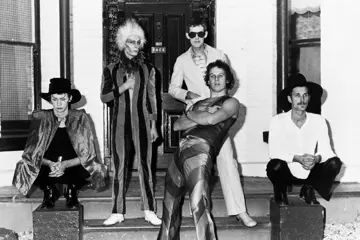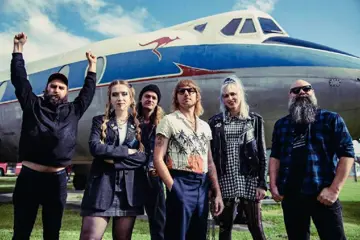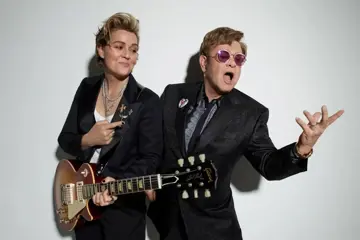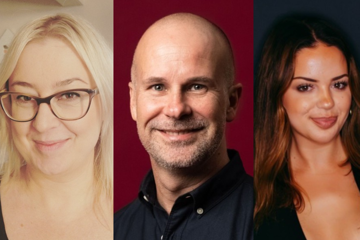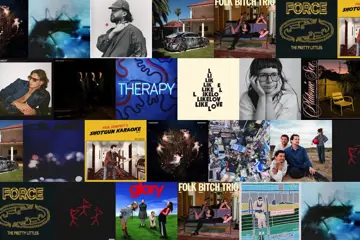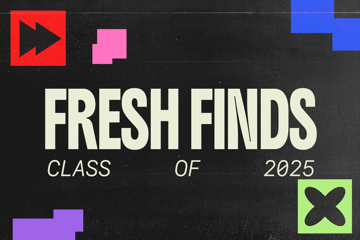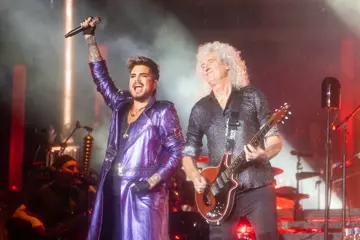Spotify’s Q4 (fourth quarter) and full 2024 figures released this month had positive news for the world’s largest streaming service.
In Q4, it gained an extra 35 million (MAUSs) monthly average users to reach a total of 675 million. Paid subscribers grew by 11 million (or 4 per cent) to hit 263 million – well ahead of the 8 million it expected.
Revenue for the whole year was €15.673 billion (AUD$25.9 billion), up 18.3 per cent. It went into profit for the first time, generating €1.138 billion ($1.88 billion). This was in contrast to a net loss of €505 million ($834.9 million) in 2023.
Last week, Spotify said it paid out a record US $10 billion to the music industry in 2024. A company executive estimated that in 2014, “around 10,000 artists generated at least $10,000 per year on Spotify. Today, well over 10,000 artists generate over $100,000 per year from Spotify alone. That’s a beautiful thing.”
Spotify’s founder and CEO, Daniel Ek, sees these figures as a game-changer for the company.
“Spotify is not only a great product — it’s now also a great business, which we’re really happy about,” he exclaimed. We’re gonna double down on music in 2025, and I’m personally very excited about that.”
Don't miss a beat with our FREE daily newsletter
He went on to say: “I am very excited about 2025. We will continue to place bets that will drive long-term impact, increasing our speed while maintaining the levels of efficiency we achieved last year.
“It’s this combination that will enable us to build the best and most valuable user experience, grow sustainably and deliver creativity to the world.”
Predictions
Spoify’s prediction for Q1 2025 is that it will add 3 million more MAUs and 2 million subscribers. In this quarter, it expects to reach revenue of €4.2 billion ($6.9 billion), which would work out to a growth of 13 per cent.
It expects operating income of €548 million ($906 million), which is a rise from the €168 million ($277.7 million) in Q1 2024.
The dazzling 2024 figures saw Spotify stocks reach a record high and give the company a market cap value of US $124 billion.
This means that Spotify is worth more than Universal, which is at $49.39 billion, and Warner Music at $16.81 billion. Sony Music is not publicly traded.
Its stock skyrocketed 178.5 per cent from a year ago, outperforming the broader tech sector.
Majors’ Share
One takeaway from the figures is that the market share of Universal Music, Sony Music Entertainment, Warner Music and digital licensing group Merlin in Spotify dropped 71 per cent through 2024.
It’s been a slow decline: at 73 per cent in 2023, 75 per cent in 2022, 77 per cent in 2021 and 78 per cent in 2020.
This fits in with the narrative that indie music is in a boom.
According to UK research company MIDiA’s State of the Independent Music Economy Report 2024 (Labels and Distributors), indie labels' global market share grew from 34.2 per cent to 46.7 per cent in 2023, generating over US$14.3 billion in revenue.
“In 2023, indies generated nearly $4.5 billion on Spotify. This marks the first year ever that Indies accounted for about half of what the entire industry generated on Spotify,” the company said.
Non-English speaking countries account for half of the 66,000 artists earning $10,000 on Spotify.
The company said, “Artists who—in the past—might have struggled to break through are now finding their audiences, and the music industry today is a more diverse and accurate reflection of the world we live in.
“Spanish, German, Portuguese, French, and Korean lead the pack for performance in languages other than English – while Hindi, Indonesian, Punjabi, Tamil, and Greek all saw huge upticks in 2023.”
The inference is that of the US$10 billion Spotify paid out to the music industry in 2024, indie artists and labels got $5 million.
Warns
But Chris Maund, co-CEO of Mushroom Music and board member of Merlin, warns that the independent sector is very diverse and not all indies are winners from the decrease in the majors’ share market share.
He stresses, “I don’t think you can conclude that because there’s a decrease in market share of the majors on Spotify that means a direct increase in the share for independent labels like Mushroom, who invest heavily in A&R. That’s not the case.
“It’s much more likely that market share is going to independent aggregators and distributors. The 100,000+ tracks a day going up on Spotify are largely coming from this sector.
“Further, the Spotify figures you quoted are global figures, and the huge growth in Spotify streaming numbers in emerging markets will skew towards indie distributors and away from majors as they don’t have as large a market share as they do in Western markets.”
Maund confirms that after rapid growth at the start of the streaming era, the income that Mushroom receives from Spotify and other DSPs has “stabilised”. Nor has its market share at Spotify risen.
But streaming’s role in breaking Australian acts globally without the need for large investment in overheads abroad is proven by these two Mushroom acts.
Lebanese-Australian dance producer Tobiahs’s euphoric Lifetime got BBC airplay after EDM influencer Peter Tong heard a bootleg copy.
“It’s had 80 million+ streams already,” relays Maund. “Only 19 per cent of that came from Australia and 81 per cent from international. We do have offices overseas, but they are nowhere near the size that [they] would have needed under the old physical paradigm to generate that kind of 81% overseas success.”
Noosa-born, Melbourne-based bedroom pop singer Mia Wray’s latest single hit a million streams in two weeks. 85 per cent were international (enough for her to tour Europe later this month), and 15 per cent from Australia and New Zealand.
“That shows how quickly we can get to global audiences..”
Remote
Another Australian independent music hub is Remote Control, set up in 2001 by Harvey Saward and Steve Cross.
It represents overseas indie labels such as Beggars Group, including 4AD, Matador Records, Rough Trade and XL Recordings and acts like Radiohead, Spoon, The Smile, The xx, Aldous Harding, Big Thief, Future Islands, Kamasi Washington, The National and Queens Of The Stone Age.
Locally, it partners with ANZ labels such as Milk! Records, Barely Dressed, Part Time Records, Pool House, Prince Melon and Club Seven, while its 21-year-old Dot Dash imprint for domestic acts includes Donny Benét, Dorsal Fins, Ngaiire, Sui Zhen, Sunbeam Sound Machine and Total Giovanni.
Saward and Cross tell TheMusic.com.au that as for their funds from Spotify, “Royalties for our international roster have increased steadily, but we have seen a decrease in royalties for our local artists.
“It’s a similar trend (with the other streaming services). Apple is our second highest, with YouTube showing strong growth.”
They add: “We would be interested to know how Spotify defines 'independent'. There are a lot of labels/artists claiming to be 'independent' when they actually have major label support and affiliations.”
Downside
Streaming has its downside for indies, of course.
A survey by MIDiA found that while labels in the northern hemisphere get most of their income from streaming, 87 per cent feel it is becoming more difficult for artists to cut through, and 78 per cent find it difficult to retain fan interest.
Maund responds to these revelations: “I’m not surprised at all; we very much relate to that. It’s a well-publicised fact that there are very few new Australian acts in the charts at the moment.
“The question is, why is it so hard for us, and for our new artists, to break through?
“That’s complicated, but, one, it has to do with there being more competition than ever, with 100,000+ new tracks going up a day. More music, more artists.
“It’s clear that streams coming from catalogue are increasing at the expense of new releases. We’re all playing our collections a lot. It’s no surprise that the algorithms are pushing older music, so that’s a factor.
“The biggest issue, which is relevant to Australia and other small English-speaking markets, and to a lesser extent the UK, is the impact of the move from traditional media to social media.
“When traditional media was dominant, it did a tremendous job of supporting Australian music, triple j being the best example of that.
“But with social media platforms, we don’t have local support pushing Australian music like we did with traditional media. We’re at the mercy of the algorithms, particularly on short-form video. Those algorithms push what is popular, and what is popular is foreign music, particularly US music.”
Fight Back
Major labels are fighting to take back their lost market share by buying into independent companies.
This week, Warner Music Group completed its full acquisition of Africori, a prominent Africa-focused music distribution, music rights management, and artist development company.
When it first invested in the Johannesburg-based company in 2020, it stated that getting Africori’s catalogue and A&R network opened the door to "establish a presence in many African markets for the first time.”
Warner also made strategic steps into India with the digital distribution platform JetSynthesys Global Music Junction and artist management and live events company E-Positive.
E-Positive’s founder and CEO, Naushad Khan, said the deal would “enable our artists to transcend the whole of India and help bring Indian culture to the rest of the world.”
Warner has also flexed its muscle in Brazil, which has now grown to be the ninth-biggest music market in the world and the largest in Latin America.
This was via Sua Música Group, the country’s largest streaming platform for regional music (with 9 million users and 16,000 acts) and with a digital distribution arm with 1,000 names.
Warner’s expansion of its indie footprints also included the January 2025 pact with DWA Records & Extravaganza, which provided it with 250 Italo disco and Eurodance tracks spanning three decades.
This follows the deal with the Netherlands’s 20-year-old Cloud 9 Recordings and its roster of labels and artists.
In the last 12 months, Sony went into 13 acquisitions or partnerships (each acquisition costing an average of $295 million), leading with Latin American distributor Altafonte, and companies in India, South Asia and Greece.
In December 2024, Universal Music Group, through Virgin Music Group, spent $775 million in acquiring Downtown Music Holdings, which included CD Baby, Fuga, AdRev, SongTrust, and Downtown.
Earlier, Universal acquired the remaining 51 per cent of PIAS, Europe’s largest independent music company, and UK-based South Asian record label Oriental Star Agencies and its 18,000 songs and video recordings.


